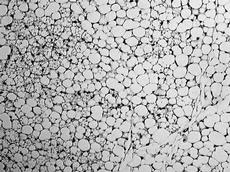Conversion from bad fat to good fat
ETH scientists have shown for the first time that white and brown fat cells can directly interconvert in a living organism from one type to the other. This finding challenges the prevailing belief that white and brown fat cells arise solely from distinct precursor cells. The knowledge will aid in the design of novel strategies to treat obesity.

The two types of fat cells that can be found in mammals could not differ more: White fat cells function mainly as highly flexible energy stores which are filled in times of calorie abundance. The fat is stored in the form of lipid droplets, which are mobilized when energy is needed. Diametrically opposed in function are the so-called brown adipocytes: These cells specialize in burning energy in the form of fat and sugar to produce heat. New-born babies possess substantial amounts of brown fat and utilize it to maintain body temperature. Since it was recently shown that brown adipocytes also exist in adult humans, research has focused on understanding how brown adipocytes are formed. The ultimate goal of these efforts is to increase brown adipocyte number and activity in obese humans, allowing them to burn excess calories and thus reduce weight.
Scientists in the laboratory of Christian Wolfrum, a professor at the Institute of Food, Nutrition and Health, have shown now for the first time that brown and white fat cells in a living organism can be converted from one cell type to the other. Their work, using mice as a model organism, provides important new insights into the origin of brown fat cells, which is a prerequisite for the development of successful anti-obesity therapies.
Against the current belief
It is known that both humans and mice can adapt to cold temperatures by forming brown fat cells within their white fat depots. These cells are called “brite” fat cells (brown-in-white) and are less common at warmer versus colder temperatures. However, the origin of these special brown adipocytes has remained a matter of debate. The prevalent hypothesis was that brite cells are formed from special precursor cells and are removed when no longer needed. The alternate idea of a direct interconversion between white and brown fat cells gained less attention. By demonstrating that this interconversion does occur and is one of the main contributors to brite fat cell formation, the current belief has been challenged.
Genetically labelled fat cells
To demonstrate how brite fat cells are formed the researchers generated mice that allowed them to genetically label specific fat cells. One model was used to label every brown cell with a stable red fluorescent marker. Another model labelled cells with a green fluorescent dye whenever they were functional brown fat cells. Using imaging techniques these labels could be used to clearly define the origin, as well as the state of a cell. Active brown adipocytes were labelled in both red and green while former brown adipocytes were labelled solely in red.
Christian Wolfrum and his doctoral student Matthias Rosenwald kept the mice in a changing environment: starting at 8°C for a week and for several weeks afterwards at normal room temperature. During the cold exposure, the mice formed brown adipocytes in their white fat depots – a process called “britening”. After warm adaptation the fat tissue turned white again. However, by fluorescent imaging it became evident that many white cells were now labelled with a fluorescent red dye, confirming that these cells developed from a formed brown adipocyte. When mice were kept again at lower temperatures these cells showed a green label again, indicating that they had converted back into brown fat cells.
From these experiments the scientists concluded that white fat cells can convert into brown fat cells and vice versa. As humans have the same type of cells as mice it is likely that the same process occurs in humans upon cold stimulation.
Treatments against obesity
“To develop new treatment strategies we need to find ways to convert white into brown adipocytes”, says Wolfrum. Most of the research has focused on identifying the precursor cells for brown fat cells, an approach that may be insufficient. Future work will address the question of how to manipulate this interconversion process either by pharmacological or by nutritional means.
This approach would represent a novel strategy. “Current anti-obesity therapies target the energy intake side of the equation by controlling appetite and the uptake of nutrients”, says Wolfrum. The pharmacological treatments that are available are not very efficient and usually are associated with side effects. In contrast, this novel approach to treat obesity would target the energy expenditure side of the equation by promoting brown fat formation.
Literature reference
Rosenwald
M, Perdikari A, Rülicke T, Wolfrum C: Bi-directional interconversion of brite
and white adipocytes. Nature Cell Biology 2013, Advance Online Publication,
DOI: 10.1038/ncb2740







READER COMMENTS